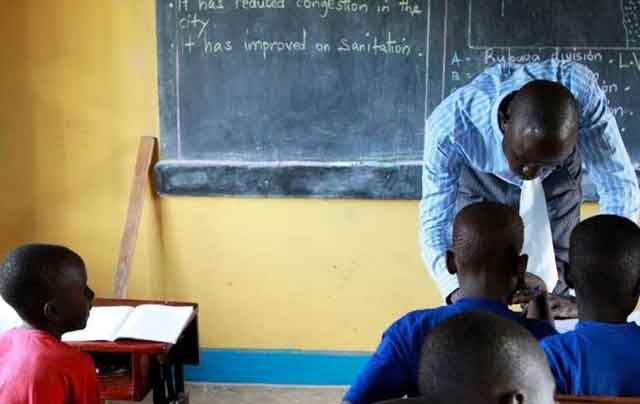
NEWS ANALYSIS | THE INDEPENDENT | As the world celebrates World Teacher’s Day, an analysis conducted by URN has shown that public schools in Uganda currently require at least 107,880 additional teachers to address the staffing shortages and achieve the desired teacher-pupil ratio. This figure is based on a recent policy paper presented by the Ministry of Education and Sport to the Cabinet, focusing on Universal Primary and Secondary Education.
As per the Ministry of Education’s internal calculations, and the recent validation exercise conducted by the Education Service Commission (ESC), the nation requires an additional workforce of over 78,880 primary school teachers to achieve the desired goal of maintaining a 1:40 teacher-pupil ratio at the primary level.
In the same report, the ministry indicates that at the secondary level, there are sufficient teachers to meet the required ratios, and the government only needs to reorganize and distribute them more evenly across the country.
However, the report by the Education Service Commission stemming from a comprehensive nationwide teacher validation exercise conducted in all post-primary institutions, including secondary schools, technical and vocational institutions, farm schools, health training schools, and teacher colleges, reveals a significant staffing shortfall.
The report highlights a concerning situation where many government post-secondary schools, especially those in rural areas, are struggling with understaffing issues, often operating with only five teachers on the government payroll.
According to the report, the current staffing gap stands at 42 percent, equating to 29,000 unfilled teaching positions in post-primary institutions.
In an interview following the report’s release, Dr. Asuman Lukwago, the secretary to ESC, emphasized that unlike in primary schools where teachers can handle a broad range of subjects, in post-primary schools and tertiary institutions, instructors specialize in specific subjects. This specialization has led to a shortage of teachers capable of covering various subjects in several public secondary schools and tertiary institutions.
“There is a huge problem in many schools. Imagine a school operating without teachers for several subjects. How do students learn these subjects,” Lukwago stated before he hastened to add that even schools that had hit their staff ceilings are also not well-off given the huge teacher-student ratio recorded.
The rural-urban divide in the education sector is also imminent when it comes to staffing levels given the fact that teachers are not deployed in sufficient numbers to some rural and hard-to-reach schools across the districts.
Available records indicate that the government last updated the staff ceiling equipment for the institutions in question in 1997.
At that time, each subject was allocated one teacher. However, speaking to URN after release of the report Rev. Prof. Luboga noted that as the student enrollment grows, this number is currently low but what worries most is that many schools don’t even meet it.
Rev. Prof. Luboga argued that apart from filling the existing staffing gaps, there is a need to raise the staff ceiling to a minimum of at least 31 teachers per school, and the maximum be determined by the teacher-student ratio. This shortage of teachers highlights a critical need for increased recruitment and support in the education sector to ensure that students receive quality education and adequate attention from their teachers.
Many more teachers are needed for the future
The Teachers Initiative in Sub-Saharan Africa – TISSA Report emphasized the challenges posed by Uganda’s rapidly growing population, which will inevitably lead to a significant increase in the number of students in the country. This demographic pressure is concerning for the education system, which is already struggling and performing poorly. By 2025, it will need to accommodate 20.6 million children aged 6 to 18.
“The expansion of the system will involve planning the building/renovation of infrastructure (schools, classrooms, and so on) as well as providing schools with learning materials and equipment (books, desks, and so on). While expanding, the system will also have to recruit an adequate number of teachers,” the report reads in part. The report, which is currently being used as a guiding campus in various education reforms, including teacher-related policies, stressed the importance of forecasting the required number of teachers in advance to effectively manage their recruitment, initial training, payment, and career development.
To address this, the report highlighted the need for an extensive expansion of the education system. This expansion would entail the construction and renovation of infrastructure such as schools and classrooms, as well as the provision of essential learning materials and equipment like books and desks. Furthermore, the system must also focus on recruiting a sufficient number of teachers. The report projected that to Meet the needs of growing learner populations at the primary level, the government needed to make Annual teacher recruitment ranging from 12,596 (low scenario) to 16,366 (high scenario), with private schools hiring around 6,150 new teachers per year.
In lower secondary education, the report outlines a low-scenario average of 4,396 new teacher recruits annually, compared to 9,981 in the high-scenario. Private schools are projected to hire between 7,815 and 8,415 new teachers each year. In upper secondary education, the low scenario foresees an average of 733 new recruits yearly in government schools, while the high scenario anticipates 974. Private schools are expected to recruit between 455 (low scenario) and 807 (high scenario) new teachers per year. Unfortunately, the report could not provide subject-specific teacher requirements at the secondary level due to a lack of precise data.
Dr. Jane Egau, the Undersecretary at the Education Ministry, points out that Uganda has successfully trained a sufficient number of teachers, boasting a significant workforce. However, the primary issue lies in their wage, making recruitment a challenge. But, she adds that is an evident problem with the distribution of this workforce.
“Most of our teachers are concentrated in urban areas, leaving rural schools understaffed. Additionally, there is an acknowledged shortage of teachers in certain subjects, particularly at the post-primary level.”
She emphasizes that as wages improve, the government can hire more teachers to bridge the staffing gaps.
Joseph Eloket, a teacher from Katakwi District, highlights that aside from the staffing shortages, current teachers are facing adverse working conditions. “Even before addressing salaries, we are working without necessary instructional materials and often teaching on empty stomachs due to the absence of provided lunches. The lack of staff quarters forces many teachers to allocate a significant portion of their salaries to rent. Some schools are located far from towns, resulting in long commutes and late arrivals,” Eloket states.
In 2018, the Ministry of Education and Sports introduced the Incentive Framework-TIF, aiming to boost teacher motivation, drive policy development, and implement a national teacher motivation strategy systematically and sustainably. This framework is expected to apply to both the public and private educational sectors at all levels. The issue of remuneration also remains a significant concern among teachers. For years, the government has promised salary increases but recently, the government raised the salaries of science teachers, causing frustration among primary school teachers and those teaching humanities at post-primary institutions, who felt unfairly treated.
However, President Yoweri Kaguta Museveni has since assured them that their remuneration will also be addressed in the upcoming financial years, bringing their pay in line with their science counterparts.
Eloket adds that low pay has discouraged talented individuals from pursuing teaching as a profession, with many opting for better-paying jobs. He asks, “Who would choose to teach for only 400,000 Dhillings, regardless of qualifications? This is insufficient. Even those who initially entered the teaching profession have left for more lucrative employment opportunities, including jobs in Saudi Arabia as domestic workers.”
Nevertheless, Dr. Egau believes that ongoing teacher reforms mandating a minimum degree requirement will uplift the profession. Under these reforms, all teachers will receive equal payment based on their qualifications.
Worldwide Problem
Meanwhile, it seems Uganda isn’t the only country with teacher shortages, new data from the UN Educational, Social and Cultural Organization (UNESCO) has revealed a global shortage of teachers as the profession faces a “major vocations crisis”.
On Wednesday, UNESCO pointed to a gap of 44 million teachers without whom the world will not be able to provide primary and secondary education for all by 2030. The agency said that the problem lies not only in a lack of funding but also in the “unattractiveness” of the profession.
UNESCO Director-General Audrey Azoulay underscored that while some regions of the world lack candidates for the job, other regions face a very high dropout rate during the first few years of work. “In both cases, the answer is the same: we must better value, better train, and better support teachers,” she said. Southern Asia is experiencing the largest lack of teachers worldwide – 7.8 million – while sub-Saharan Africa alone accounts for one in three of the current global shortfall.
In the 79 countries studied by UNESCO to better understand the reasons for the shortage, the attrition rate among primary school teachers almost doubled from 4.6 percent in 2015 to 9 percent in 2022. The UN agency said that three main factors stand out: poor working conditions, high levels of stress, and low pay. UNESCO made a number of recommendations to countries to improve the status of teachers.
***
URN
 The Independent Uganda: You get the Truth we Pay the Price
The Independent Uganda: You get the Truth we Pay the Price



